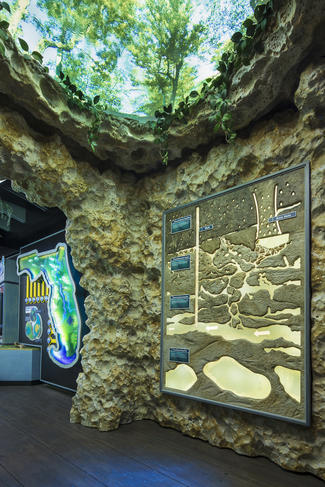The Floridan Aquifer

About the Aquifer
On the outside of the WaterVentures truck there is a beautiful image of the Floridan Aquifer. The Aquifer is a vast underground cave full of porous limestone rock. Rainfall seeps through the different layers of the earth, which act as natural filters, and enters the aquifer through a process called percolation.
Water leaves the aquifer naturally through springs. Florida has more than 600 freshwater springs, one of the largest concentrations of springs on Earth. Springs are ranked according to the volume of water flowing from the ground. Discharge from Florida’s springs can range from less than 1 pint per minute (Eighth Magnitude) to more than 64.6 million gallons per day (First Magnitude).
The aquifer systems under Florida provide the majority of the state’s water. There are two major aquifers in Florida: the Floridan, and the Biscayne. The Floridan Aquifer is the largest and deepest in the state, it stretches for 82,000 square miles beneath Florida and parts of Alabama, Georgia, and South Carolina.
To learn more about the Aquifer’s role in the Water Cycle, we recommend you visit www.floridasprings.org. On this site you can try out the interactive tour of the journey of Florida’s water to the springs and see where the springs are located throughout Florida.

Human Impacts and Water Conservation
Humans regularly impact the aquifer systems in Florida. Changes in the landscape and land use, such as paved roads, parking lots, shopping centers, and housing developments and other buildings, tend to alter the quality and quantity of water that seeps into an aquifer. Additionally, the aquifer’s water quality is sensitive to pollutants, such as lawn fertilizers, pesticides, and animal waste, which run off of our own backyards or other developed areas and seep into the ground.
There are many simple ways to use water wisely and protect the Aquifer in Florida. Turning off the water when you brush your teeth, using a broom instead of a hose to clean off your driveway, and watering outdoors only in the early morning or late afternoon are small steps that everyone can take to preserve this precious, natural resource.
There are 5 water management districts throughout Florida that protect and manage water resources for the continued welfare of people and natural systems. Every resident of Florida should become familiar with their water management district to learn more about where their water comes from, ways to conserve water and find out about any restoration or conservation efforts in their area.
To see which water management district jurisdiction your home falls within, visit http://www.dep.state.fl.us/secretary/watman/
Sources:
http://www.dep.state.fl.us/springs/faq.htm
http://www.ucnsb.org/ftp/br_flaquifer.pdf
http://www.sjrwmd.com/aquifer/